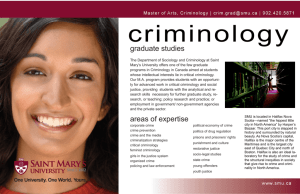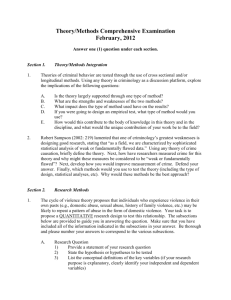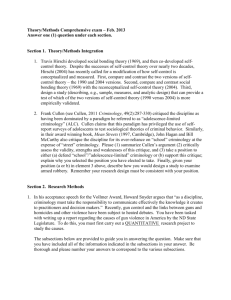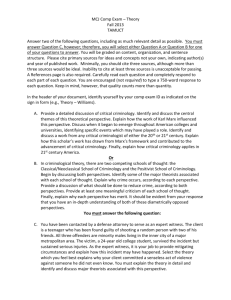Robert Agnew, Toward a Unified Criminology: Integrating
advertisement
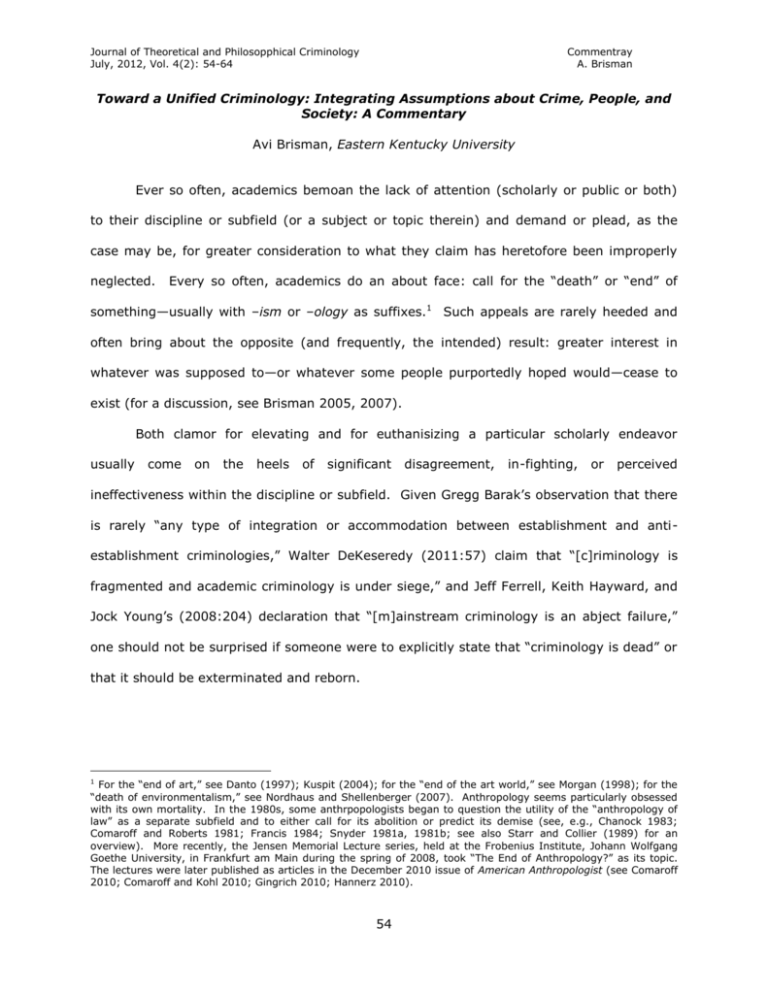
Journal of Theoretical and Philosopphical Criminology July, 2012, Vol. 4(2): 54-64 Commentray A. Brisman Toward a Unified Criminology: Integrating Assumptions about Crime, People, and Society: A Commentary Avi Brisman, Eastern Kentucky University Ever so often, academics bemoan the lack of attention (scholarly or public or both) to their discipline or subfield (or a subject or topic therein) and demand or plead, as the case may be, for greater consideration to what they claim has heretofore been improperly neglected. Every so often, academics do an about face: call for the “death” or “end” of something—usually with –ism or –ology as suffixes.1 Such appeals are rarely heeded and often bring about the opposite (and frequently, the intended) result: greater interest in whatever was supposed to—or whatever some people purportedly hoped would—cease to exist (for a discussion, see Brisman 2005, 2007). Both clamor for elevating and for euthanisizing a particular scholarly endeavor usually come on the heels of significant disagreement, in-fighting, or perceived ineffectiveness within the discipline or subfield. Given Gregg Barak’s observation that there is rarely “any type of integration or accommodation between establishment and antiestablishment criminologies,” Walter DeKeseredy (2011:57) claim that “[c]riminology is fragmented and academic criminology is under siege,” and Jeff Ferrell, Keith Hayward, and Jock Young’s (2008:204) declaration that “[m]ainstream criminology is an abject failure,” one should not be surprised if someone were to explicitly state that “criminology is dead” or that it should be exterminated and reborn. 1 For the “end of art,” see Danto (1997); Kuspit (2004); for the “end of the art world,” see Morgan (1998); for the “death of environmentalism,” see Nordhaus and Shellenberger (2007). Anthropology seems particularly obsessed with its own mortality. In the 1980s, some anthrpopologists began to question the utility of the “anthropology of law” as a separate subfield and to either call for its abolition or predict its demise (see, e.g., Chanock 1983; Comaroff and Roberts 1981; Francis 1984; Snyder 1981a, 1981b; see also Starr and Collier (1989) for an overview). More recently, the Jensen Memorial Lecture series, held at the Frobenius Institute, Johann Wolfgang Goethe University, in Frankfurt am Main during the spring of 2008, took “The End of Anthropology?” as its topic. The lectures were later published as articles in the December 2010 issue of American Anthropologist (see Comaroff 2010; Comaroff and Kohl 2010; Gingrich 2010; Hannerz 2010). 54 Journal of Theoretical and Philosopphical Criminology July, 2012, Vol. 4(2): 54-64 Commentray A. Brisman Were he less humble, Robert Agnew, Samuel Candler Dobbs Professor of Sociology at Emory University and President-Elect of the American Society of Criminology, might undertake a Lazarus-like project in Toward a Unified Criminology: Integrating Assumptions about Crime, People, and Society: pronounce that criminology has run its course and then attempt to resuscitate it with a strain of theoretical DNA that coincidentally matches his scholarly progeny. For Agnew, disagreements and divisions within criminology have, indeed, prevented it from constructing a general or unified theory of crime (p.viii), rendered criminologists unable to explain most of the variance in crime (p.viii, 5), impeded their agreement on recommendations for controlling crime (p.5), and reduced the likelihood that criminologists will be heard and listened to by policymakers (p.5). While deeply troubled by this inertia and the backbiting and bickering that has contributed to it, Agnew does not, to switch biblical metaphors, present a flood story or build a vessel to save us from a divine deluge. Instead, Toward a Unified Criminology: Integrating Assumptions about Crime, People, and Society is a more modest tale in which Agnew attempts to repair the alleged fragmentation in criminology and to disprove accusations of the discipline’s failure. In his earlier study, Why Do Criminals Offend? A General Theory of Crime and Delinquency (2005), Agnew asserted that all major theories of crime possess some relevance and that a “complete explanation of crime” must integrate these theories, describe the relationship between them, and explain how they work together to affect crime. A “general theory of crime,” Agnew maintained, must answer seven questions: 1) what are the major causes of crime?; 2) why do these causes increase the likelihood of crime?; 3) how are the causes of crime related to one another?; 4) what effect does crime have on its ‘causes’ (and what effect does prior crime have on subsequent crime)?; 5) how do the causes interact with one another in affecting crime?; 6) what are the timing and form of causal effects; and 7) what factors affect the level and operation of the direct causes of crime? Examining research on the relationship between crime, individual traits, and the social environment, and tying together the key contributions from social learning, control, 55 Journal of Theoretical and Philosopphical Criminology July, 2012, Vol. 4(2): 54-64 Commentray A. Brisman labeling, and bio-psychological theories of crime, among others, Agnew proposed a general theory to explain individual differences in the extent of crime (i.e., differences in offending between individuals), patterns of offending over the life course (i.e., “within-individual” levels of offending over the life course), and group differences in crime rates. Although Agnew stands by the general theory promulgated in Why Do Criminals Offend? A General Theory of Crime and Delinquency, he admits, at the beginning of Toward a Unified Criminology: Integrating Assumptions about Crime, People, and Society, that the former endeavor did not devote sufficient attention to the underlying assumptions about the nature of crime, people, society, and reality (p.vi). Claiming that the assumptions criminologists make about these areas influence their work and lie at the root of the divisions in criminology, Agnew sets out examine, analyze, integrate and extend the different assumptions made by current criminological theories and perspectives so as to establish a more solid foundation on which to construct a general theory of crime. In this way, Toward a Unified Criminology: Integrating Assumptions about Crime, People, and Society serves as a prequel to Why Do Criminals Offend? A General Theory of Crime and Delinquency. After explaining why he feels that criminology is a “divided discipline” (p.2)— essentially, a schism between mainstream and critical criminologists—Agnew outlines the five assumptions (which serve as the five substantive chapters of Toward a Unified Criminology: Integrating Assumptions about Crime, People, and Society) that he asserts must be confronted and the differences between them resolved before we can hold “any hope for a unified criminology” (p.6): a) the definition of crime (Chapter 2); b) determinism versus agency (Chapter 3); c) the nature of human nature (Chapter 4); d) the nature of society (Chapter 5); and 5) the nature of reality (Chapter 6). For each of these chapters, Agnew describes the underlying assumptions (presenting those made by mainstream criminologists before turning to alternative ones, usually made by critical criminologists); the impact of these assumptions on the discipline of criminology (specifically, the types of 56 Journal of Theoretical and Philosopphical Criminology July, 2012, Vol. 4(2): 54-64 Commentray A. Brisman crimes contemplated, their causes, their recommended control strategies, the methods employed); and the evidence regarding the accuracy or utility of the different assumptions. Each chapter closes with a reformulated assumption or set of assumptions that integrate and extend those previously discussed. Agnew concludes Toward a Unified Criminology: Integrating Assumptions about Crime, People, and Society with Chapter 7, where he reviews the differences in underlying assumptions, emphasizes that all underlying assumptions have some support, summarizes his new set of (integrated and extended) assumptions, and then outlines next steps for examining underlying assumptions and exploring additional assumptions—in furtherance of a unified theory of crime. Despite its humility, Toward a Unified Criminology: Integrating Assumptions about Crime, People, and Society is an ambitious enterprise. Lengthy treatises and entire university courses have examined whether the definition “crime” should include harmful behaviors not proscribed by law (Chapter 2), whether behavior is fully determined or whether individuals possess “free will” or agency to make and act on their choices (Chapter 3), whether people are self-interested, socially concerned, or “blank slates” (Chapter 4), whether society is characterized by consensus or conflict (Chapter 5), and whether there is an objective reality or whether reality is socially constructed (Chapter 6). Without a doubt, some will object to Agnew’s reformulated assumptions or his review of the evidence supporting various assumptions. I would have preferred a more robust discussion of “autonomy” and “power” than the one that Agnew relegates to the footnotes of Chapter 3 and, in Chapter 4, would have liked to have seen greater attention to psychoanalytic perspectives on altruism (see, e.g., Seelig and Dobelle 2001; Seelig and Rosof 2001) and work in evolutionary biology on deceipt and self-deception (see, e.g., Trivers 2011). In fact, expanding the evidence for some of the various assumptions in criminology is a worthwhile endeavor for all criminologists, irrespective of their theoretical orientation or 57 Journal of Theoretical and Philosopphical Criminology July, 2012, Vol. 4(2): 54-64 view of Agnew’s overall endeavor.2 Commentray A. Brisman Agnew manages to cover a substantial amount of research that has or should inform the assumptions underlying criminological theory, but his discussion is far from exhaustive. Doing so, however, would have sacrificed the book’s readability—Toward a Unified Criminology: Integrating Assumptions about Crime, People, and Society is an amazingly accessible book. Thus, readers should treat evidence that is missing or that Agnew under-analzes as an invitation, rather than a shortcoming. In a shorter review of Toward a Unified Criminology: Integrating Assumptions about Crime, People, and Society (Brisman In Press), I argued that the most compelling questions in the book pertain not to Agnew’s conclusions (the integrated and extended assumptions) or his means of arriving at them, but his underlying premise (i.e., that criminology is a divided discipline) and the purpose the book is intended to serve (i.e., build a foundation for a unified theory of crime). Notwithstanding Agnew’s assertions (as well those of Barak and DeKeseredy above), I questioned whether criminology really is a divided discipline. As Agnew himself admits, criminology is unique among academic disciplines in that it studies a single topic (crime) from a variety of perspectives, rather than a range of topics from a common perspective, as anthropology, psychology, and sociology do (see p.13). At the same time, Agnew notes that “criminology has become more interdisciplinary in nature, drawing on a broader range of scholars and more readily incorporating outside research” (p.199). If criminology is divided, I asked, is it any more divided than, say, evolutionary biology—a field that was recently described as one “that seems to lapse into discord every decade or so” (Lehrer 2012:40)? Does criminology risk reversing course and losing some of its interdisciplinary vitality by working towards unity and integration? At what point does 2 For instance, “childhood” is as much as contested concept as “crime” and one whose meaning, scope, and parameters—like that of “crime”—differs across cultures and over time (see generally Johnson 2012; Weil 2012). In Chapter 4, Agnew notes research in evolutionary psychology on the biological basis of various behaviors and traits, as well as research studying behaviors and traits that emerge in infancy. A more thorough examination of literature from other disciplines on “adolescence,” “adulthood,” “childhood,” and “youth,” for example, would wellserve criminologists interested in the etiology of criminal, delinquent, and deviant behavior. Keith Hayward’s (2012) engagement with the dynamics and features of “emerging adulthood” in psychology is a recent, notable example, but more could be undertaken in this regard. 58 Journal of Theoretical and Philosopphical Criminology July, 2012, Vol. 4(2): 54-64 Commentray A. Brisman healthy debate and the energetic exchange of ideas produce disciplinary divides? Has criminology, indeed, reached this point (assuming that this can be measured)? If criminology is a divided discipline, I continued, is this such an unfortunate development? Agnew points to the inability of criminologists to agree on recommendations for controlling crime and the decreasing likelihood that policymakers will listen to criminologists as evidence of the pernicious effect of criminology’s divisiveness. But is this the only way to measure a discipline’s ambit and well-being? Throughout Toward a Unified Criminology: Integrating Assumptions about Crime, People, and Society, Agnew alternates between discussing the need for a “unified theory of crime” and a “unified criminology.” These are different matters, however; criminology is much more than the search for why people commit crime so that we can control crime. Though I expressed reservations about whether we should reformulate the underlying assumptions of criminology and use this integration towards a unified theory of crime, I stressed that a little more open-mindedness towards differing underlying assumptions would well serve criminologists on personal, professional, and intellectual levels.3 I ended my review by urging criminologists, regardless of whether they were convinced by Agnew’s position about criminology as a divided discipline and the need to something about it (i.e., build a unified theory of crime) to heed his call to discuss and empirically examine the underlying assumptions of the discipline. My position has not changed and in the space provided me here, I wish to build upon some of the ideas expressed in the shorter review that I wrote for Theoretical Criminology. I am not sure that criminology is a divided discipline or, if it is, whether it is any more 3 To be clear, I am not opposed to theory integration as a strategy for explaining more of the variation in crime. As Agnew makes clear in Chapter 1—and as he has described elsewhere (see, e.g., Cullen and Agnew 2011)—the history of criminology is replete with efforts at theoretical integration and one could argue that efforts at integration are as much a part of the intellectual history of criminology as individual theory development. While I understand that theories often develop in opposition to one another and that at some level integration may fundamentally alter and thereby destroy the beauty and utility of individual theories, I disagree with Hirschi (1989:39) that it is “virtually pointless” to try to bring theories together in “pleasing and satisfactory” ways. My point, as discussed further below, is that developing a unified theory of crime causation should not be viewed as the raison d’être of criminology: there are multiple Meccas. 59 Journal of Theoretical and Philosopphical Criminology July, 2012, Vol. 4(2): 54-64 Commentray A. Brisman divided than any other “living” disciplines that have undergone significant internal strife and self-proclaimed threats to their legitimacy and future. I would also reassert that criminology is much more than the study of the causes of crime and its control. While these are important routes on the criminological map, many criminologists follow a different and no less important path, studying what crime means to people (e.g., crime as a form of expression, crime in forms of expression). In as much as we might investigate the underlying assumptions that inform our beliefs about the causes of crime so that we can better explain variation in crime (which, Agnew contends, would better enable us to agree on recommendations for controlling crime), we might also use our study of crime as a lens with which to understand broader phenomena about a society. What can the study of crime in China and Japan, for example, tell us about the former’s position on human rights and the latter’s position on respect and conformity? To offer another example, the Zapotecs— indigenous people of Mexico—require the powerful to be more responsible than the powerless and thus penalize the rich who steal more severely than the poor (Nader 1980). Moreover, in Zapotec culture, endangering the interests of the Commons is among the most serious cases that are referred to court (Nader 2003). What do these practices tell us about Zapotec social relations and worldviews—and what do our lack of similar sanctions tell us about our own? Or, to offer a third example, consider the July 2012 shooting that took place in a crowded movie theater in Aurora, Colorado. Criminological study of the shooting could reveal something about the nature of (or deficincies in) psychiatric care and gun control law in the United States (see, e.g., Frosch 2012; Schwartz 2012). But were we to limit our inquiry to questions regarding causation, prevention, and control, we would miss the chance to learn about the emotions that this type of event evokes, as well as the scope, extent, and emerging ways in which grief is expressed publicly (see, e.g., Preston 2012). These aspects of the shooting can reveal much about the absence or presence of anomie, standards, and values in contemporary U.S. culture—important lessons in and of themselves and ones which have bearing on the very issues of crime causation and control. 60 Journal of Theoretical and Philosopphical Criminology July, 2012, Vol. 4(2): 54-64 Commentray A. Brisman In sum, Toward a Unified Criminology: Integrating Assumptions about Crime, People, and Society is a book that forces criminology to be introspective and reflective. In so doing, it puts criminology at a sort of disciplinary crossroads. The path entitled “a unified theory of crime” may lead us toward a “unified theory of crime causation,” which may, in turn, lead to an avenue headed to capitals, legislative hills, and policymakers awaiting the delivery of prevention and control recommendations. The path entitled “disciplinary enlightenment” is a bit more discursive and meandering. It contains numerous exits, jughandles, cul-de-sacs, and dead-end streets, as well as bridges, tunnels, peaks, valleys, and scenic overlooks. It is also under construction in parts and unfinished. Travelers should understand that neither road leads to a “unified criminology”; any trail so marked will no more bring those on the road to the advertised destination as the Tower of Babel delivered settlers of Shinnar to the heavens. The interstate marked “a unified theory of crime” is not a “better” conduit than the one labeled “disciplinary enlightenment” or vice versa. They are different ways headed in different directions; they do not meet in Loch Lomond. For now, I elect the more scenic disciplinary route, provided I can pick up the occasional hitchiker (to share stories and the driving), stay in Citizens’ Band radio contact with my friends on the other route, and perhaps switch roads if I so desire when the two intersect. 61 Journal of Theoretical and Philosopphical Criminology July, 2012, Vol. 4(2): 54-64 Commentray A. Brisman References Agnew, Robert. 2005. Why Do Criminals Offend? A General Theory of Crime and Delinquency. Los Angeles: Roxbury. Brisman, Avi. In Press. Review of Toward a Unified Criminology: Integrating Assumptions about Crime, People, and Society. Theoretical Criminology 0(0). Brisman, Avi. 2007. Toward a More Elaborate Typology of Environmental Values: Liberalizing Criminal Disenfranchisement Laws and Policies. New England Journal on Criminal & Civil Confinement 33(2):283-457. Brisman, Avi. 2005. Review of The End of Art. NAEA News 47(6): 9. Barak, Gregg. 2003. Revisionist History, Visionary Criminology, and Needs-Based Justice. Contemporary Justice Review 6(3): 217-25. Chanock, Martin. 1983. Signposts or Tombstones? Reflections on Recent Works on the Anthropology of Law. Law in Context 1:107-25. Comaroff, John. 2010. The End of Anthropology, Again: On the Future of an In/Discipline. American Anthropologist 112(4): 524–38. Comaroff, John, and Karl-Heinz Kohl. 2010. Introduction to “In Focus: (Not) The End of Anthropology, Again? Some Thoughts on Disciplinary Futures.” American Anthropologist 112(4): 522–23. Comaroff, John L., and Simon Roberts. 1981. Rules and Processes: The Cultural Logic of Dispute in an African Context. Chicago: The University of Chicago Press. Cullen, Francis T., and Robert Agnew. 2011. Criminological Theory: Past to Present. 4/e. New York: Oxford University Press. Danto, Arthur C. 1997. After the End of Art: Contemporary Art and the Pale of History. Princeton: Princeton University Press. DeKeseredy, Walter S. 2011. Contemporary Critical Criminology. London and New York: Routledge. Ferrell, Jeff, Keith Hayward, and Jock Young. 2008. Cultural Criminology: An Invitation. London: Sage. Frosch, Dan. 2012. Colorado Shooting Suspect Was Getting Psychiatric Care. The New York Times. July 27. Francis, Paul. 1984. New Directions in the Study of African Law. Africa 54(4):81-88. Gingrich, Andre. 2010. Transitions: Notes on Sociocultural Anthropology’s Present and Its Transnational Potential. American Anthropologist 112(4): 552–62. Hannerz, Ulf. 2010. Diversity Is Our Business. American Anthropologist 112(4): 539–51. Hayward, Keith. 2012. Pantomime justice: A cultural criminological analysis of ‘life stage 62 Journal of Theoretical and Philosopphical Criminology July, 2012, Vol. 4(2): 54-64 Commentray A. Brisman dissolution’. Crime Media Culture 8(2): 213-29. Hirschi, Travis. 1989. Exploring Alternatives to Integrated Theory. In Theoretical Integration in the Study of Deviance and Crime: Problems and Prospects, Steven F. Messner, Marvin D. Krohn, and Allen E. Liska, eds. Pp. 37-50. Albany, NY: State University of New York Press. Johnson, Ken. 2012. The Hundred-Year Childhood. The New York Times. July 27: C21, C26. Kuspit, Donald. 2004. The End of Art. New York: Cambridge University Press. Lehrer, Jonah. 2012. Dept. of Science: Kin and Kind: Evolution and the origins of altruism. The New Yorker Mar. 5:36-42. Morgan, Robert C. 1998. The End of the Art World. New York: Allworth Press. Nader, Laura. 2003. Crime as a Category—Domestic and Globalized. In Crime’s Power: Anthropologists and the Ethnography of Crime, Philip C. Parnell and Stephanie C. Kane, eds. Pp. 55-76. New York: Palgrave Macmillan. Nader, Laura. 1980. No Access to Law: Alternatives to the American Judicial System. New York: Academic Press. Nordaus, Ted, and Michael Shellenberger. 2007. Break Through: From the Death of Environmentalism to the Politics of Possibility. New York: Houghton Mifflin. Preston, Jennifer. 2012. Social Media Tributes to the Victims of the Colorado Shooting. The New York Times. July 22. Accessed at: http://thelede.blogs.nytimes.com/2012/07/22/remembering-the-victims-of-coloradoshooting/?gwh=78A8809684F6A4A46AFB0F60E91E6123. Schwartz, John. 2012. In Columbine’s Wake, Colorado Had Become Key Player in Gun Law Debate. The New York Times. July 20. Seelig Beth J., and William H. Dobelle. 2001. Altruism and the Volunteer: Psychological Benefits from Participating as a Research Subject. ASAIO Journal 47(1): 3-5. Seelig, Beth J., and Lisa S. Rosof. 2001. Normal and Pathological Altruism. Journal of the American Psychoanalytic Association 49: 933-59. Snyder, Francis. 1981a. Capitalism and Legal Change: An African Transformation. New York. Snyder, Francis. 1981b. Anthropology, Dispute Processes, and Law: A Critical Introduction. British Journal of Law and Society 8(2):141-80. Starr, June, and Jane F. Collier. 1989. Introduction: Dialogues in Legal Anthropology. In June Starr and Jane F. Collier, eds. History and Power in the Study of Law: New Directions in Legal Anthropology. Pp.1-28. Ithaca: Cornell University Press. Trivers, Robert. 2011. The Folly of Fools: The Logic of Deceipt and Self-Deception in Human Life. New York: Basic Books. Weil, Elizabeth. 2012. The Incredible Shrinking Childhood. The New York Times Magazine. 63 Journal of Theoretical and Philosopphical Criminology July, 2012, Vol. 4(2): 54-64 Commentray A. Brisman Apr. 1: 30-35. 64

